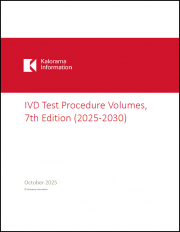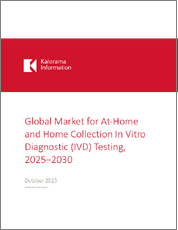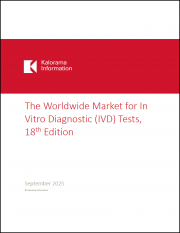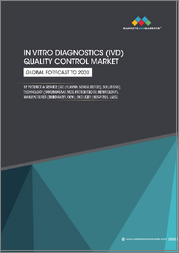
|
시장보고서
상품코드
1822358
세계의 체외진단 시장 예측(-2032년) : 제품 유형, 기술, 샘플 유형, 검사장소, 용도, 최종사용자, 지역별 세계 분석In-vitro Diagnostics Market Forecasts to 2032 - Global Analysis By Product Type (Instruments, Reagents & Consumables, and Software & Services), Technology, Sample Type, Test Location, Application, End User and By Geography |
||||||
Stratistics MRC에 따르면 세계의 체외진단 시장은 2025년에 1,165억 3,000만 달러를 차지하며 2032년에는 1,945억 9,000만 달러에 달할 것으로 예측되며, 예측 기간 중 CAGR은 7.6%입니다.
체외진단(IVD)은 혈액, 소변, 조직 등의 생물학적 검체를 분석하여 질병, 장애, 감염증을 확인하는 것입니다. 이러한 진단에는 분자 분석, 면역학적 방법, 생화학적 검사 등의 방법이 사용되며, 검사실이나 현장 검사 시스템을 통해 외부에서 시행됩니다. IVD는 조기 발견, 질병 모니터링, 치료 최적화 등 현대 헬스케어에 필수적인 요소입니다. 또한 정밀의료에도 크게 기여하여 맞춤형 의료 솔루션과 환자 관리 결과를 개선할 수 있도록 보장합니다.
CDC에 따르면 암, 당뇨병, 천식 등 만성 신장질환과 호흡기 질환 등 만성질환은 미국에서 매년 10명 중 7명이 사망하고 있습니다.
만성질환 및 감염성 질환의 확산
당뇨병, 심혈관질환, 암 등 만성질환이 전 세계에서 급증하면서 정확한 진단 검사의 필요성이 높아지고 있습니다. 동시에 반복적으로 발생하는 감염병은 신속하고 확장 가능한 검사 플랫폼에 대한 투자를 촉구하고 있습니다. 분자진단, 차세대 염기서열 분석(NGS), 액체생검의 기술 발전은 조기 발견과 질병 모니터링에 변화를 가져오고 있습니다. 선진국과 신흥 국가를 막론하고 인구 고령화가 진행되면서 루틴 진단에 대한 수요가 더욱 증가하고 있습니다. 의료 시스템은 치료 결정을 내리기 위해 개인화된 검사 프로토콜을 통합하여 치료 결정을 내리고 있습니다. 이러한 인구 통계학적 변화와 기술 혁신의 융합이 IVD 시장을 발전시키고 있습니다.
제한적 상환 정책
많은 의료 지불자는 새로운 기술, 특히 고가의 분자 플랫폼을 포함한 기술의 적용에 대해 신중한 태도를 취하지 않고 있습니다. 전 세계에서 통일된 상환 기준이 없기 때문에 새로운 시장에 진입하는 제조업체에게는 불확실성이 존재합니다. 소규모 진단약 제조업체는 복잡한 청구 코드와 지불자와의 협상의 어려움에 직면해 있습니다. 이러한 경제적 모호성은 기술 혁신을 지연시키고, 의료 서비스가 부족한 지역에서 최첨단 진단 의약품에 대한 접근성을 제한합니다. 정책 개혁이 없다면, 상환의 병목현상은 앞으로도 시장 확대를 계속 억제할 가능성이 있습니다.
재택 진단에 대한 수요 증가
만성질환 모니터링 및 감염성 질환 검진을 위해 휴대가 간편하고 사용이 편리한 키트를 찾는 소비자가 늘고 있습니다. 마이크로플루이딕스공학, 스마트폰 일체형 바이오센서, 클라우드 기반 분석 기술 등의 혁신으로 임상 현장 밖에서도 실시간 결과를 얻을 수 있게 되었습니다. 규제기관은 원격의료 대응 진단약의 신속한 승인을 통해 이러한 추세를 촉진하고 있습니다. 신흥 시장에서는 특히 농촌이나 외딴 지역에서 재택 검사가 빠르게 확산되고 있습니다. 이러한 진화는 개인 맞춤형 치료와 예방적 건강관리를 위한 새로운 길을 열어가고 있습니다.
데이터 프라이버시 및 사이버 보안에 대한 우려
클라우드 기반 진단 시스템과 AI 기반 분석에는 강력한 암호화와 세계 데이터 보호법 준수가 필요합니다. 건강 데이터 유출은 환자의 신뢰를 떨어뜨리고 기업을 법적 책임에 노출시킬 수 있습니다. 진단 워크플로우에 IoT 지원 장치를 통합하면 사이버 보안 프로토콜이 복잡해집니다. 투명한 데이터 처리와 위반 보고 의무화로 인해 규제 당국의 감시가 더욱 엄격해지고 있습니다. 사이버 보안 인프라에 대한 적극적인 투자가 없다면, 디지털 진단은 평판 리스크와 업무 리스크에 직면할 수 있습니다.
COVID-19의 영향
COVID-19는 체외진단의 상황을 극적으로 변화시켰고, 신속 검사 및 원격 진단에 대한 수요를 가속화했습니다. 록다운은 공급망에 혼란을 가져왔지만, POC(Point-Of-Care)와 분자 플랫폼의 기술 혁신을 촉진했습니다. 긴급사용허가는 새로운 검사법의 신속한 보급을 가능하게 하고, 원격의료 통합은 진단의 범위를 확대했습니다. 병원은 검사량을 효율적으로 관리하기 위해 자동화와 디지털 워크플로우를 우선순위에 두었습니다. 팬데믹 이후 전략은 회복력을 중시하게 되었고, 제조업체들은 분산 생산과 AI를 활용한 진단약에 투자하고 있습니다.
예측 기간 중 장비 부문이 가장 클 것으로 예측됩니다.
검사 장비 부문은 실험실 자동화 및 고처리량 검사에서 중요한 역할을 하므로 예측 기간 중 가장 큰 시장 점유율을 차지할 것으로 예측됩니다. 고급 분석 장비, PCR 시스템, 면역 분석 플랫폼은 병원 및 진단 실험실 전체 임상 워크플로우의 핵심입니다. 로봇공학, 멀티플렉싱, 커넥티비티 분야의 끊임없는 기술 혁신으로 업무 효율성과 진단 정확도가 향상되고 있습니다. 다양한 검사 유형과 원격 모니터링 기능을 지원하는 통합 시스템에 대한 수요가 증가하고 있습니다. 각 제조업체들은 진화하는 실험실의 요구에 대응하기 위해 모듈형 설계와 클라우드 지원 장비에 집중하고 있습니다. 정밀진단이 대중화됨에 따라 검사 장비는 확장 가능한 검사 인프라의 중추가 될 것입니다.
예측 기간 중 감염성 질환 분야가 가장 높은 CAGR을 보일 것으로 예측됩니다.
예측 기간 중 신종 병원체에 대한 전 세계적인 노력에 힘입어 감염성 질환 분야가 가장 높은 성장률을 보일 것으로 예측됩니다. 신속 진단 키트, 분자 분석, 증후군 패널은 조기 발견 및 발병 억제를 위해 도입되었습니다. CRISPR 기반 진단과 휴대용 핵산 검사의 기술적 혁신은 현장 진단의 형태를 바꾸고 있습니다. 정부와 NGO는 전염병 대응 및 항균제 내성 모니터링을 위한 확장 가능한 플랫폼에 투자하고 있습니다. 여행 관련 감염병과 인수공통전염병 증가는 민첩한 검사 솔루션에 대한 수요를 더욱 증가시키고 있습니다. 이 분야는 빠르게 진화하고 있으며, 혁신은 속도, 감도, 접근성에 초점을 맞추었습니다.
가장 큰 점유율을 차지하는 지역:
예측 기간 중 아시아태평양은 의료 인프라의 확대와 질병 부담 증가에 힘입어 가장 큰 시장 점유율을 차지할 것으로 예측됩니다. 중국, 인도, 일본과 같은 국가들은 진단의 현대화와 현지 제조 능력에 투자하고 있습니다. 정부 주도의 노력으로 농촌 지역과 의료 서비스가 부족한 지역의 검사 접근성이 개선되고 있습니다. 이 지역에서는 자동 분석기 및 AI를 활용한 진단 플랫폼의 도입이 진행되고 있습니다. 세계 기업과 지역 기업과의 전략적 제휴를 통해 기술 이전과 시장 침투가 가속화되고 있습니다.
CAGR이 가장 높은 지역:
예측 기간 중 북미는 진단 혁신과 디지털 헬스 통합 분야의 리더십에 힘입어 가장 높은 CAGR을 나타낼 것으로 예측됩니다. 미국과 캐나다는 유전체학, 액체생검, AI를 활용한 진단을 선구적으로 개발하고 있습니다. 규제 당국은 신규 검사 승인을 위한 경로를 간소화하여 시장 진입을 보다 신속하게 촉진하고 있습니다. 병원은 검사 워크플로우를 최적화하기 위해 클라우드 기반 검사실 관리 시스템과 예측 분석을 도입하고 있습니다. 이 지역은 강력한 상환 지원과 예방적 진단에 대한 소비자의 높은 인식의 혜택을 누리고 있습니다.
무료 커스터마이징 서비스:
이 보고서를 구독하는 고객은 다음과 같은 무료 맞춤화 옵션 중 하나를 이용할 수 있습니다.
- 기업소개
- 추가 시장 기업 종합 프로파일링(최대 3사)
- 주요 기업의 SWOT 분석(최대 3사)
- 지역 세분화
- 고객의 관심에 따른 주요 국가별 시장 추정, 예측, CAGR(주: 타당성 확인에 따라 다름)
- 경쟁사 벤치마킹
- 제품 포트폴리오, 지역적 입지, 전략적 제휴를 기반으로 한 주요 기업 벤치마킹
목차
제1장 개요
제2장 서문
- 개요
- 이해관계자
- 조사 범위
- 조사 방법
- 데이터 마이닝
- 데이터 분석
- 데이터 검증
- 조사 어프로치
- 조사 자료
- 1차 조사 자료
- 2차 조사 자료
- 전제조건
제3장 시장 동향 분석
- 촉진요인
- 억제요인
- 기회
- 위협
- 제품 분석
- 기술 분석
- 용도 분석
- 최종사용자 분석
- 신흥 시장
- COVID-19의 영향
제4장 Porters Five Force 분석
- 공급 기업의 교섭력
- 바이어의 교섭력
- 대체품의 위협
- 신규 진출업체의 위협
- 경쟁 기업 간 경쟁 관계
제5장 세계의 체외진단 시장 : 제품 유형별
- 기기
- 시약과 소모품
- 소프트웨어와 서비스
제6장 세계의 체외진단 시장 : 기술별
- 면역진단
- ELISA
- CLIA
- 신속 검사
- 형광 면역측정
- 분자진단
- PCR/RT-PCR
- 등온 증폭(INAAT)
- 마이크로어레이
- 시퀀싱
- 임상화학
- 효소 어세이
- 전해질 분석
- 혈액학
- CBC 애널라이저
- 응고 검사
- 미생물학
- 배양에 기반한 진단
- 항균제 감수성 시험
제7장 세계의 체외진단 시장 : 샘플 유형별
- 혈액
- 조직
- 뇨
- 타액
제8장 세계의 체외진단 시장 : 검사장소별
- 연구실 기반 검사
- POCT(Point-of-Care Testing)
- 재택 검사
제9장 세계의 체외진단 시장 : 용도별
- 감염증
- 유전성 질환
- 종양학
- 약물 검사
- 심장병학
- 신장학
- 자가면역질환
- 당뇨병
- 기타 용도
제10장 세계의 체외진단 시장 : 최종사용자별
- 병원
- 홈케어 설정
- 임상 검사실
- 의사 진료소
- 기타 최종사용자
제11장 세계의 체외진단 시장 : 지역별
- 북미
- 미국
- 캐나다
- 멕시코
- 유럽
- 독일
- 영국
- 이탈리아
- 프랑스
- 스페인
- 기타 유럽
- 아시아태평양
- 일본
- 중국
- 인도
- 호주
- 뉴질랜드
- 한국
- 기타 아시아태평양
- 남미
- 아르헨티나
- 브라질
- 칠레
- 기타 남미
- 중동 및 아프리카
- 사우디아라비아
- 아랍에미리트
- 카타르
- 남아프리카공화국
- 기타 중동 및 아프리카
제12장 주요 발전
- 계약, 파트너십, 협업, 조인트 벤처
- 인수와 합병
- 신제품 발매
- 사업 확대
- 기타 주요 전략
제13장 기업 프로파일링
- Roche
- Illumina
- Abbott Laboratories
- Agilent Technologies
- Siemens Healthineers
- DiaSorin
- Thermo Fisher Scientific
- Hologic
- Danaher Corporation
- QuidelOrtho
- bioMerieux
- Becton Dickinson(BD)
- Sysmex Corporation
- QIAGEN
- Bio-Rad Laboratories
According to Stratistics MRC, the Global In-Vitro Diagnostics Market is accounted for $116.53 billion in 2025 and is expected to reach $194.59 billion by 2032 growing at a CAGR of 7.6% during the forecast period. In-Vitro Diagnostics (IVD) involves analyzing biological specimens, including blood, urine, and tissue, to identify diseases, disorders, or infections. Conducted externally, either in laboratories or through point-of-care testing systems, these diagnostics utilize methods such as molecular assays, immunological techniques, and biochemical testing. IVD is essential in modern healthcare, offering early detection, disease monitoring, and treatment optimization. It also contributes significantly to precision medicine, ensuring tailored healthcare solutions and improved patient management outcomes.
According to CDC, chronic diseases such as cancer & diabetes and chronic kidney & respiratory diseases, such as asthma, are responsible for 7 in 10 deaths in the U.S. each year.
Market Dynamics:
Driver:
Rising prevalence of chronic and infectious diseases
The global surge in chronic illnesses such as diabetes, cardiovascular disorders, and cancer is intensifying the need for accurate diagnostic testing. Simultaneously, recurring outbreaks of infectious diseases are prompting investments in rapid and scalable testing platforms. Technological advancements in molecular diagnostics, next-generation sequencing (NGS), and liquid biopsy are transforming early detection and disease monitoring. Aging populations across developed and emerging regions are further amplifying demand for routine diagnostics. Healthcare systems are increasingly integrating personalized testing protocols to guide treatment decisions. This convergence of demographic shifts and technological innovation is propelling the IVD market forward.
Restraint:
Limited reimbursement policies
Many healthcare payers remain cautious about covering newer technologies, especially those involving high-cost molecular platforms. The lack of harmonized global reimbursement standards creates uncertainty for manufacturers entering new markets. Smaller diagnostic firms face challenges navigating complex billing codes and payer negotiations. This financial ambiguity slows innovation and limits access to cutting-edge diagnostics in underserved regions. Without policy reform, reimbursement bottlenecks may continue to constrain market expansion.
Opportunity:
Rising demand for home-based diagnostics
Consumers are increasingly seeking portable, user-friendly kits for chronic disease monitoring and infectious disease screening. Innovations in microfluidics, smartphone-integrated biosensors, and cloud-based analytics are enabling real-time results outside clinical settings. Regulatory bodies are supporting this trend by fast-tracking approvals for telehealth-compatible diagnostics. Emerging markets are witnessing rapid adoption of home-based testing, especially in rural and remote areas. This evolution is opening new pathways for personalized care and preventive health management.
Threat:
Data privacy and cybersecurity concerns
Cloud-based diagnostic systems and AI-driven analytics require robust encryption and compliance with global data protection laws. Breaches in health data can erode patient trust and expose companies to legal liabilities. The integration of IoT-enabled devices into diagnostic workflows adds complexity to cybersecurity protocols. Regulatory scrutiny is increasing, with mandates for transparent data handling and breach reporting. Without proactive investment in cybersecurity infrastructure, digital diagnostics may face reputational and operational risks.
Covid-19 Impact
The pandemic dramatically reshaped the IVD landscape, accelerating demand for rapid testing and remote diagnostics. Lockdowns disrupted supply chains, but also catalyzed innovation in point-of-care and molecular platforms. Emergency use authorizations enabled swift deployment of new assays, while telehealth integration expanded diagnostic reach. Hospitals prioritized automation and digital workflows to manage testing volumes efficiently. Post-pandemic strategies now emphasize resilience, with manufacturers investing in decentralized production and AI-powered diagnostics.
The instruments segment is expected to be the largest during the forecast period
The instruments segment is expected to account for the largest market share during the forecast period, due to its critical role in laboratory automation and high-throughput testing. Advanced analyzers, PCR systems, and immunoassay platforms are central to clinical workflows across hospitals and diagnostic labs. Continuous innovation in robotics, multiplexing, and connectivity is enhancing operational efficiency and diagnostic accuracy. Demand is rising for integrated systems that support multiple test types and remote monitoring capabilities. Manufacturers are focusing on modular designs and cloud-enabled instruments to meet evolving lab needs. As precision diagnostics gain traction, instruments remain the backbone of scalable testing infrastructure.
The infectious diseases segment is expected to have the highest CAGR during the forecast period
Over the forecast period, the infectious diseases segment is predicted to witness the highest growth rate, driven by global efforts to combat emerging pathogens. Rapid diagnostic kits, molecular assays, and syndromic panels are being deployed for early detection and outbreak control. Technological breakthroughs in CRISPR-based diagnostics and portable nucleic acid testing are reshaping field diagnostics. Governments and NGOs are investing in scalable platforms for pandemic preparedness and antimicrobial resistance monitoring. The rise of travel-related infections and zoonotic diseases is further boosting demand for agile testing solutions. This segment is evolving rapidly, with innovation focused on speed, sensitivity, and accessibility.
Region with largest share:
During the forecast period, the Asia Pacific region is expected to hold the largest market share supported by expanding healthcare infrastructure and rising disease burden. Countries like China, India, and Japan are investing in diagnostic modernization and local manufacturing capabilities. Government-led initiatives are improving access to testing in rural and underserved regions. The region is witnessing strong uptake of automated analyzers and AI-powered diagnostic platforms. Strategic collaborations between global players and regional firms are accelerating technology transfer and market penetration.
Region with highest CAGR:
Over the forecast period, the North America region is anticipated to exhibit the highest CAGR, underpinned by its leadership in diagnostic innovation and digital health integration. The U.S. and Canada are pioneering developments in genomics, liquid biopsy, and AI-enhanced diagnostics. Regulatory agencies are streamlining pathways for novel test approvals, encouraging faster market entry. Hospitals are adopting cloud-based lab management systems and predictive analytics to optimize testing workflows. The region benefits from strong reimbursement support and high consumer awareness of preventive diagnostics.
Key players in the market
Some of the key players profiled in the In-Vitro Diagnostics Market include Roche, Illumina, Abbott Laboratories, Agilent Technologies, Siemens Healthineers, DiaSorin, Thermo Fisher Scientific, Hologic, Danaher Corporation, QuidelOrtho, bioMerieux, Becton Dickinson (BD), Sysmex Corporation, QIAGEN, and Bio-Rad Laboratories.
Key Developments:
In February 2025, Shedd Aquarium and Abbott are announcing one of Shedd's largest corporate gifts in recent history - a $10 million pledge from Abbott and Abbott's philanthropic foundation, Abbott Fund. The investment cements the longstanding partnership between Shedd, Abbott, and Abbott Fund to enrich the cultural, educational and environmental fabric of Chicago and spark passion for protecting the ocean environment.
In May 2025, Roche announced a strategic collaboration with Broad Clinical Labs to develop and pilot groundbreaking applications using Roche's recently unveiled next-generation sequencing (NGS) Sequencing By Expansion (SBX) technology. This collaboration will focus on harnessing the power of the SBX technology to transform clinical genomics and biomedical discovery. It will also aim to establish the SBX technology as a routine offering for fast, scalable sequencing for Broad Clinical Lab's research community.
Product Types Covered:
- Instruments
- Reagents & Consumables
- Software & Services
Technologies Covered:
- Immunodiagnostics
- Molecular Diagnostics Capsule
- Clinical Chemistry
- Hematology
- Microbiology
Sample Types Covered:
- Blood
- Tissue
- Urine
- Saliva
Test Locations Covered:
- Laboratory-based Testing
- Point-of-Care Testing (POCT)
- Home-based Testing
Applications Covered:
- Infectious Diseases
- Genetic Disorders
- Oncology
- Drug Testing
- Cardiology
- Nephrology
- Autoimmune Disorders
- Diabetes
- Other Applications
End Users Covered:
- Hospitals
- Homecare Settings
- Clinical Laboratories
- Physician Offices
- Other End Users
Regions Covered:
- North America
- US
- Canada
- Mexico
- Europe
- Germany
- UK
- Italy
- France
- Spain
- Rest of Europe
- Asia Pacific
- Japan
- China
- India
- Australia
- New Zealand
- South Korea
- Rest of Asia Pacific
- South America
- Argentina
- Brazil
- Chile
- Rest of South America
- Middle East & Africa
- Saudi Arabia
- UAE
- Qatar
- South Africa
- Rest of Middle East & Africa
What our report offers:
- Market share assessments for the regional and country-level segments
- Strategic recommendations for the new entrants
- Covers Market data for the years 2024, 2025, 2026, 2028, and 2032
- Market Trends (Drivers, Constraints, Opportunities, Threats, Challenges, Investment Opportunities, and recommendations)
- Strategic recommendations in key business segments based on the market estimations
- Competitive landscaping mapping the key common trends
- Company profiling with detailed strategies, financials, and recent developments
- Supply chain trends mapping the latest technological advancements
Free Customization Offerings:
All the customers of this report will be entitled to receive one of the following free customization options:
- Company Profiling
- Comprehensive profiling of additional market players (up to 3)
- SWOT Analysis of key players (up to 3)
- Regional Segmentation
- Market estimations, Forecasts and CAGR of any prominent country as per the client's interest (Note: Depends on feasibility check)
- Competitive Benchmarking
- Benchmarking of key players based on product portfolio, geographical presence, and strategic alliances
Table of Contents
1 Executive Summary
2 Preface
- 2.1 Abstract
- 2.2 Stake Holders
- 2.3 Research Scope
- 2.4 Research Methodology
- 2.4.1 Data Mining
- 2.4.2 Data Analysis
- 2.4.3 Data Validation
- 2.4.4 Research Approach
- 2.5 Research Sources
- 2.5.1 Primary Research Sources
- 2.5.2 Secondary Research Sources
- 2.5.3 Assumptions
3 Market Trend Analysis
- 3.1 Introduction
- 3.2 Drivers
- 3.3 Restraints
- 3.4 Opportunities
- 3.5 Threats
- 3.6 Product Analysis
- 3.7 Technology Analysis
- 3.8 Application Analysis
- 3.9 End User Analysis
- 3.10 Emerging Markets
- 3.11 Impact of Covid-19
4 Porters Five Force Analysis
- 4.1 Bargaining power of suppliers
- 4.2 Bargaining power of buyers
- 4.3 Threat of substitutes
- 4.4 Threat of new entrants
- 4.5 Competitive rivalry
5 Global In-vitro Diagnostics Market, By Product Type
- 5.1 Introduction
- 5.2 Instruments
- 5.3 Reagents & Consumables
- 5.4 Software & Services
6 Global In-vitro Diagnostics Market, By Technology
- 6.1 Introduction
- 6.2 Immunodiagnostics
- 6.2.1 ELISA
- 6.2.2 CLIA
- 6.2.3 Rapid Tests
- 6.2.4 Fluorescence Immunoassay
- 6.3 Molecular Diagnostics
- 6.3.1 PCR / RT-PCR
- 6.3.2 Isothermal Amplification (INAAT)
- 6.3.3 Microarrays
- 6.3.4 Sequencing
- 6.4 Clinical Chemistry
- 6.4.1 Enzymatic Assays
- 6.4.2 Electrolyte Analysis
- 6.5 Hematology
- 6.5.1 CBC Analyzers
- 6.5.2 Coagulation Testing
- 6.6 Microbiology
- 6.6.1 Culture-based Diagnostics
- 6.6.2 Antimicrobial Susceptibility Testing
7 Global In-vitro Diagnostics Market, By Sample Type
- 7.1 Introduction
- 7.2 Blood
- 7.3 Tissue
- 7.4 Urine
- 7.5 Saliva
8 Global In-vitro Diagnostics Market, By Test Location
- 8.1 Introduction
- 8.2 Laboratory-based Testing
- 8.3 Point-of-Care Testing (POCT)
- 8.4 Home-based Testing
9 Global In-vitro Diagnostics Market, By Application
- 9.1 Introduction
- 9.2 Infectious Diseases
- 9.3 Genetic Disorders
- 9.4 Oncology
- 9.5 Drug Testing
- 9.6 Cardiology
- 9.7 Nephrology
- 9.8 Autoimmune Disorders
- 9.9 Diabetes
- 9.10 Other Applications
10 Global In-vitro Diagnostics Market, By End User
- 10.1 Introduction
- 10.2 Hospitals
- 10.3 Homecare Settings
- 10.4 Clinical Laboratories
- 10.5 Physician Offices
- 10.6 Other End Users
11 Global In-vitro Diagnostics Market, By Geography
- 11.1 Introduction
- 11.2 North America
- 11.2.1 US
- 11.2.2 Canada
- 11.2.3 Mexico
- 11.3 Europe
- 11.3.1 Germany
- 11.3.2 UK
- 11.3.3 Italy
- 11.3.4 France
- 11.3.5 Spain
- 11.3.6 Rest of Europe
- 11.4 Asia Pacific
- 11.4.1 Japan
- 11.4.2 China
- 11.4.3 India
- 11.4.4 Australia
- 11.4.5 New Zealand
- 11.4.6 South Korea
- 11.4.7 Rest of Asia Pacific
- 11.5 South America
- 11.5.1 Argentina
- 11.5.2 Brazil
- 11.5.3 Chile
- 11.5.4 Rest of South America
- 11.6 Middle East & Africa
- 11.6.1 Saudi Arabia
- 11.6.2 UAE
- 11.6.3 Qatar
- 11.6.4 South Africa
- 11.6.5 Rest of Middle East & Africa
12 Key Developments
- 12.1 Agreements, Partnerships, Collaborations and Joint Ventures
- 12.2 Acquisitions & Mergers
- 12.3 New Product Launch
- 12.4 Expansions
- 12.5 Other Key Strategies
13 Company Profiling
- 13.1 Roche
- 13.2 Illumina
- 13.3 Abbott Laboratories
- 13.4 Agilent Technologies
- 13.5 Siemens Healthineers
- 13.6 DiaSorin
- 13.7 Thermo Fisher Scientific
- 13.8 Hologic
- 13.9 Danaher Corporation
- 13.10 QuidelOrtho
- 13.11 bioMerieux
- 13.12 Becton Dickinson (BD)
- 13.13 Sysmex Corporation
- 13.14 QIAGEN
- 13.15 Bio-Rad Laboratories



















